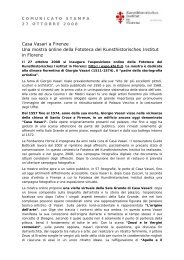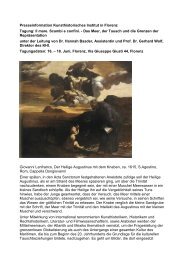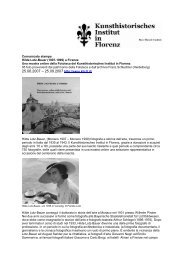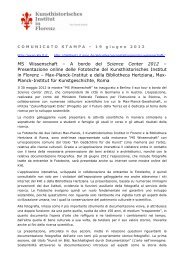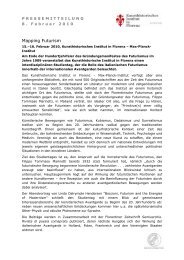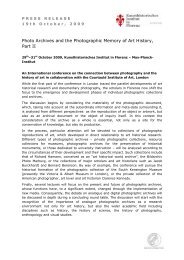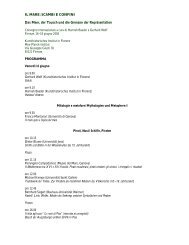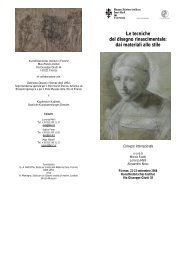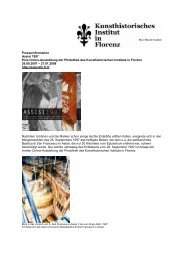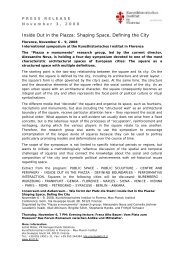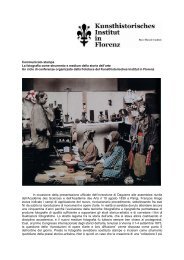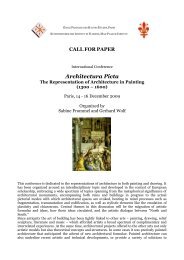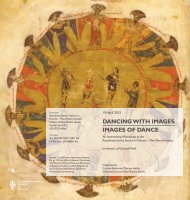juli 2012 - Kunsthistorisches Institut in Florenz
juli 2012 - Kunsthistorisches Institut in Florenz
juli 2012 - Kunsthistorisches Institut in Florenz
You also want an ePaper? Increase the reach of your titles
YUMPU automatically turns print PDFs into web optimized ePapers that Google loves.
24 | WISSENSCHAFTLICHE VERANSTALTUNGEN<br />
30.06.–02.07.2011<br />
Aesthetics and Techniques of L<strong>in</strong>es between Draw<strong>in</strong>g and Writ<strong>in</strong>g<br />
International Conference (CIHA Colloquium)<br />
E<strong>in</strong>e Kooperation des KHI mit dem Gab<strong>in</strong>etto Disegni e Stampe degli Uffizi<br />
Organisation: Marzia Faietti und Gerhard Wolf<br />
Crist<strong>in</strong>a Acid<strong>in</strong>i/<br />
Welcome<br />
Claudio Di Benedetto<br />
Shigetoshi Osano (Tokyo) What About: The Ch<strong>in</strong>ese Literati’s View of Calligraphy and Pa<strong>in</strong>t<strong>in</strong>g (» 書 画 « shuhua): a Reconsideration<br />
of What is Considered Art <strong>in</strong> Ch<strong>in</strong>a and Japan<br />
Marzia Faietti/Gerhard Wolf Introduction<br />
David Roxburgh (Cambridge, MA) Abd al-Rahman al-Sufi’s Uranometry Treatise Kitab suwar al-kawakib al-thabita (Book of Forms of the<br />
Fixed Stars) c. 965<br />
Ivan Drpić (Cambridge, MA) Pa<strong>in</strong>ter as Scribe: Self-Fashion<strong>in</strong>g and the Arts of Graphē <strong>in</strong> the Late Medieval Balkans<br />
Nataša Golob (Ljubljana) Some Aspects of Calligraphy Around 1500: Borders of Interplay<br />
Jaynie Anderson (Melbourne) What Circles May Mean. Indigenous Australian L<strong>in</strong>es from Prehistory to the Digital Age<br />
Thierry Dufrêne (Paris)<br />
La ligne décorative: la marque de l’art islamique dans l’art française, de Matisse à Morellet<br />
Robert Felfe (Berl<strong>in</strong>)<br />
The L<strong>in</strong>e as ›Epistemic Th<strong>in</strong>g‹ <strong>in</strong> Early Modern Europe<br />
Alessandro Della Latta (Florence) Metamorfosi dei nomi<br />
Francesca Tanc<strong>in</strong>i (Bologna) Grafema, pittogramma, immag<strong>in</strong>e e ritorno. Walter Crane e le illustrazioni vittoriane per l’<strong>in</strong>fanzia<br />
Jessica Dandona (Beaumont, TX) ›Écriture artiste‹: Inscription as Ornament <strong>in</strong> a F<strong>in</strong>-de-Siècle Vase by Émile Gallé<br />
Nicola Suthor (Hamburg) Den Kontur der Figur ausschreiben: Zu Theorie und Praxis e<strong>in</strong>er Koord<strong>in</strong>ationsübung am Bauhaus und<br />
darüber h<strong>in</strong>aus<br />
Henry Francis Skerritt (Melbourne) Old Way/New Way: Pictur<strong>in</strong>g a Kunw<strong>in</strong>jku Art History Through Contemporary Approaches to the L<strong>in</strong>e<br />
Jovanka Popova (Skopje) Graffiti Language<br />
Davood Khoshniyat (Tehran) Representational and Figurative Significance of Scripture <strong>in</strong> Saqqakhaneh School<br />
Michelle Y<strong>in</strong>g-L<strong>in</strong>g Huang Rhythm and Calligraphic Expression <strong>in</strong> Contemporary Ch<strong>in</strong>ese Art<br />
(Hong Kong)<br />
LaoZhu (Beij<strong>in</strong>g)<br />
L<strong>in</strong>es Are One and the Same <strong>in</strong> Ch<strong>in</strong>ese Art: The Supreme Pr<strong>in</strong>ciple <strong>in</strong> the Aesthetics and Techniques<br />
of Ch<strong>in</strong>ese Traditional Art<br />
Alexander Schwan (Berl<strong>in</strong>) Bewegungsl<strong>in</strong>eaturen. Tanz als Körperkalligraphie am Beispiel von L<strong>in</strong> Hwai-m<strong>in</strong>s Cursive II<br />
Horst Bredekamp (Berl<strong>in</strong>) Unter der L<strong>in</strong>ie. Überlegungen zum Bewegungsvektor zeichnender Denker<br />
11.–12.07.2011<br />
Recht, Bild und Raum: visuelle und juristische Interpretationen<br />
Workshop<br />
E<strong>in</strong>e Kooperation des MPI für europäische Rechtsgeschichte, Frankfurt a. M. mit dem KHI<br />
Organisation: Barbara Dölemeyer, Thomas Duve und Alessandro Nova<br />
Veranstaltungsort: MPI für europäische Rechtsgeschichte, Frankfurt a. M.<br />
Alessandro Nova<br />
Christoph Meyer<br />
Carol<strong>in</strong> Behrmann<br />
Christiane Birr<br />
Caspar Ehlers<br />
Imke Wartenberg<br />
Laura Goldenbaum<br />
Ruth Wolff<br />
Karl Härter<br />
Brigitte Sölch<br />
Barbara Dölemeyer<br />
E<strong>in</strong>führung<br />
Öffentlichkeit im Recht des späten Mittelalters: Kirche und Publizität<br />
Augensche<strong>in</strong> und Geometrie. Zu Bartolo da Sassoferratos Tyberiades und der »forma corporativa«<br />
Die staatsrechtliche Diskussion um das Eigentum an Kunstgegenständen <strong>in</strong> landesherrlichen<br />
Sammlungen des 18. und 19. Jahrhunderts<br />
Die Funktion von Plätzen im Bezugssystem von Stadt und Umland<br />
Visualisierung von Ordnungssystemen <strong>in</strong> Räumen der Rechtsprechung. Recht und Gerechtigkeit<br />
<strong>in</strong> politischen Bildprogrammen des spätmittelalterlichen Italien<br />
Abbild und Recht – Die Verkörperung der rechtsphilosophischen Anschauung im Bronzegisant der<br />
italienischen Frührenaissance<br />
Die Wappen der Podestà <strong>in</strong> <strong>Florenz</strong> – Zur Visualisierung des ›Anderen‹ als Darstellung der eigenen<br />
Rechtsordnung<br />
Das <strong>in</strong>szenierte Attentat: Zur medialen Repräsentation politischer Verbrechen und strafrechtlicher<br />
Reaktionen im frühneuzeitlichen Europa<br />
Momente des Schreckens – Schwellen- und Passagenräume <strong>in</strong> der frühneuzeitlichen Architektur(theorie)<br />
Zur Ikonographie der Gesetzgebung<br />
08.–10.09.2011<br />
Art, Space and Mobility<br />
International Workshop<br />
Organisation: Ashley Jones, Mattia Guidetti und Emanuele Lugli mit Hannah Baader, Av<strong>in</strong>oam Shalem und Gerhard Wolf<br />
Elizabeth Williams<br />
Clemente Beghi<br />
Yuka Kadoi<br />
Norio Sh<strong>in</strong>ohara<br />
Ruggero Longo<br />
Serena Martucci<br />
Kristoffer Damgaard<br />
Wear<strong>in</strong>g Silver <strong>in</strong> the Medieval Middle East<br />
At the End of the Silk Road: Cont<strong>in</strong>ental Influences <strong>in</strong> the Art of Asuka and Nara Japan<br />
The Iconography of the Lotus<br />
Considerations Concern<strong>in</strong>g the Production Technique of Buddhist Clay Figures <strong>in</strong> Central Asia and Western<br />
Regions<br />
Opus Sectile Decoration <strong>in</strong> Norman South Italy and the Language of Ornament <strong>in</strong> the Medieval Mediterranean<br />
Wall-Pa<strong>in</strong>t<strong>in</strong>g Decoration <strong>in</strong> the Medieval Middle di Scarfizzi East: Highlights from the Citadel of Shayzar<br />
Globaliz<strong>in</strong>g Structures – Structur<strong>in</strong>g Globalization: Mobility and Exchange <strong>in</strong> the Early Islamic Red Sea<br />
(650–1100 CE)



